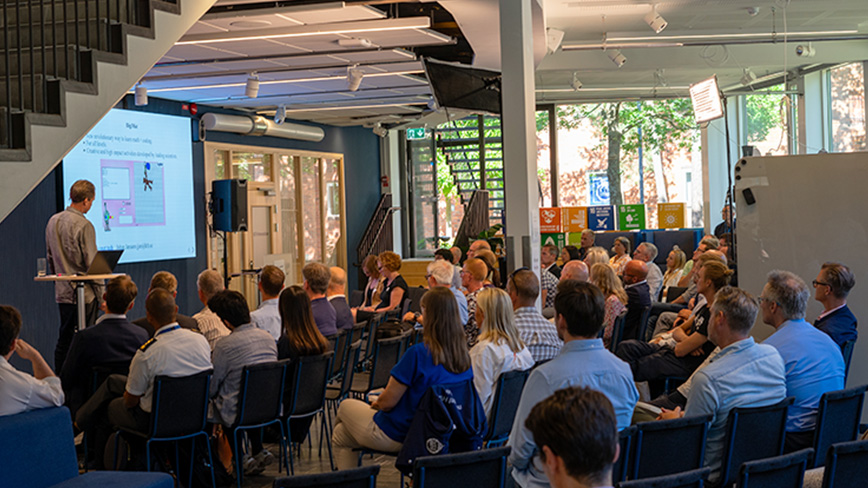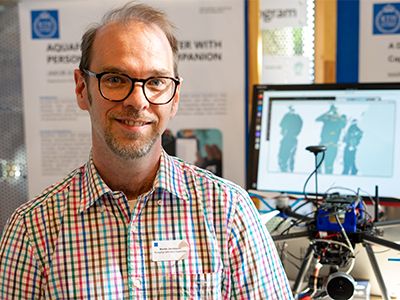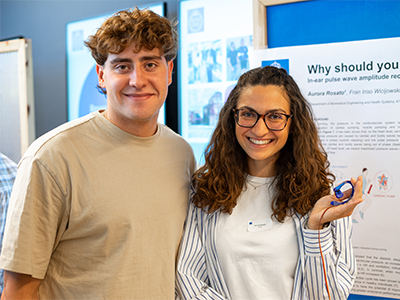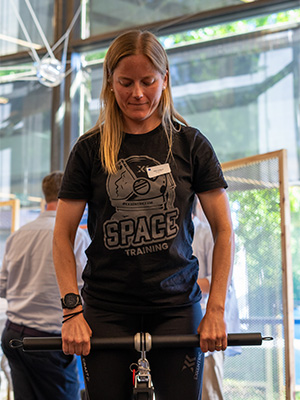Well-attended inauguration of the KTH Center for Sports Technology

Drones for motion analysis, innovative exercise machines and heart rhythm-synchronized running – these are three of the approximately 20 projects presented at the opening of KTH's newest research center.
“It was a successful opening of operations for our Center for Sports Technology,” says director Gunnar Karlsson, professor of telecommunications systems.
Over a hundred people had gathered in KTH Innovation's premises at the opening on 13 June. KTH President Anders Söderholm's opening speech was followed by eight presentations on everything from ice rink technology to data visualization. Videos of the presentations will be published on the KTH Center for Sports Technology website.
Drones that follow athletes

After the presentations, researchers and visitors gathered in the exhibition hall to check out the some 20 projects represented. One of the participants was lecturer Martin Jakobsson and his drone.
“In this project, we have equipped a drone with a depth camera. The idea is that it should follow an athlete performing an activity, for example, a 10,000-meter walk. The drone will film the person and perform various analyses,” says Martin Jakobsson.
Getting out of the lab and being able to film for a longer period is the whole point, according to Martin Jakobsson. Of course, there are motion capture labs today, but there it is difficult to simulate how a runner actually moves in terrain over time, and some sports cannot be filmed indoors at all.
”It is the movement analysis that we are after. If it is about running, we want to see if you have a good running style and symmetry, how you behave when you start to get tired and how you behave when running uphill and downhill.”
The impact of heart rate on performance

Opposite Martin Jakobsson, doctoral student Aurora Rosato talks excitedly about her project.
“The main goal is to study the interaction between the cardiovascular system and the locomotor system. In this way, we can improve the performance of athletes, especially runners. We can also improve the rehabilitation of patients with heart failure,” says Aurora Rosato.
Her team has developed a prototype to sense the heart rhythm in the ear of a runner who should aim to run in time with the expansion of the heart.
“In this way, we show that blood flow is maximized when you step with the right timing. This increases blood flow to your brain and improves your overall performance.”

Flywheel machines for flexible strength training
In the middle of the showroom, Salli Carlfjord from the company Exxentric stands by an original looking exercise machine.
“We make strength training machines that are flywheel-based, they have a flywheel as resistance instead of classic weights. It is a very flexible way to train, because you do not need as many weights. Depending on how much effort you put in, the difficulty will change. So two people of different strengths can train on the same wheel,” says Salli Carlfjord.
The company was founded in 2011 and has several collaborations with KTH. Four master's students from KTH have done project work here, two of whom got jobs at the company.
Text: Jon Lindhe
